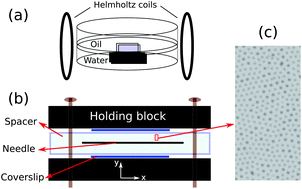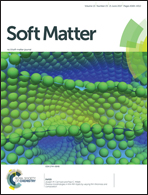Shear-induced reversibility of 2D colloidal suspensions in the presence of minimal thermal noise†
Abstract
The effects of minimal thermal noise on particle rearrangements in cyclically sheared colloidal suspensions are experimentally investigated using particle tracking methods. Our experimental model system consists of polystyrene microspheres adsorbed at an oil–water interface, in which the particles exhibit small but non-negligible Brownian motion. Experiments are performed on bidisperse (1.0 and 1.2 μm in diameter) systems, which form area fractions of 0.20 and 0.32 at the interface. We first characterize the thermal (Brownian) noise using particle diffusivities at quiescent states, and show that under our experimental flow conditions both systems (0.20 and 0.32 area fraction) behave as athermal, in the sense that the particle diffusion time scale is larger than the flow time scale. We then characterize particle rearrangements as a function of strain amplitude, and show that small but finite levels of thermal noise affect the reversibility dynamics, even in effectively athermal systems. Our data indicate that as thermal noise is slightly increased in a cyclically sheared athermal system, the fraction of reversible rearrangements is reduced, the reversible cycles become unstable, and the rearrangement hysteresis is significantly hindered.



 Please wait while we load your content...
Please wait while we load your content...